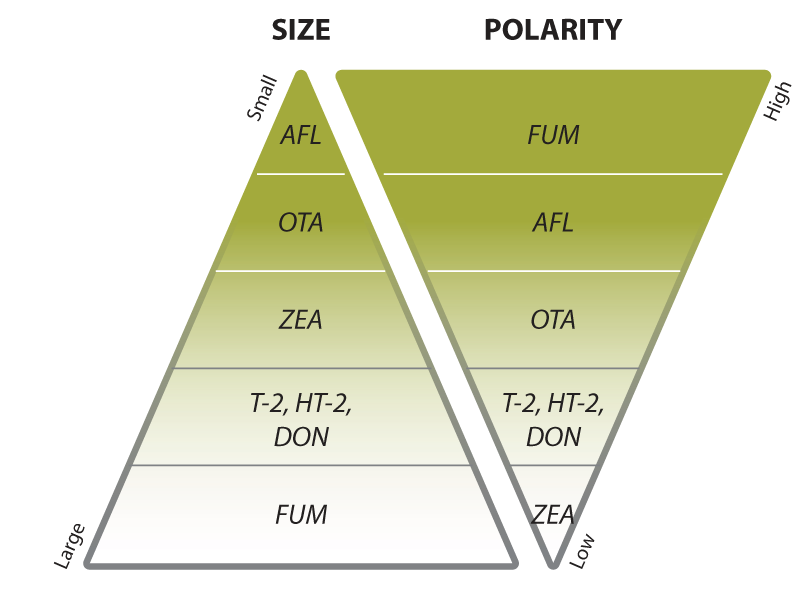What makes a good mycotoxin binder?
As a preventive measure, mycotoxin detoxifying agents should be routinely added to animal feed to reduce the detrimental effects of mycotoxins on animal health and growth. When it comes to mycotoxin detoxification, there is always a great deal of confusion about choosing the appropriate product. In general, considerations should be given to the following aspects when evaluating mycotoxin detoxification products:
Broad spectrum binding activity

Mycotoxins can be classified by their chemical and physical properties, including polarity, solubility, size and shape of the molecules. These properties, especially polarity and size, influence the efficacy of the adsorbents. An efficient mycotoxin binder should adsorb polar and non-polar as well as small and large mycotoxins. Although varieties of mycotoxin adsorbing agents are commercially available, the most commonly applied products are aluminosilicates. In their natural form, clay minerals are efficient binders for high polarity and small size mycotoxins, such as aflatoxin. Many of them have limited or no activity against the non-polar and larger mycotoxins, such as zearalenone (ZEA), deoxynivalenol (DON), fumonisins (FUM) and T-2 toxins. However, through certain modification methods the physical and chemical properties of the clay surface can be improved, enabling it to bind a wider range of mycotoxins. Moreover, the components of yeast cell walls (e.g. β-D-glucan) have adsorption sites that bind mycotoxins via various mechanisms, including hydrogen bonds and hydrophobic interactions. Therefore, the combination of modified clay minerals and selected yeast cell wall components opens up possibilities for broad spectrum binding of mycotoxins.
Retention of mycotoxins
For many binders, the adsorption of mycotoxins is reversible and sensitive to the changes in pH. The amount of the environmental H+ and OH– influences the interaction between the mycotoxins and the surface of the adsorbent. In general, mycotoxins are adsorbed better in acidic conditions than in neutral or basic conditions. The pH of the gastro-intestinal tract of production animals rapidly changes from highly acidic in the stomach to about pH 6-7 in the small intestine. Hence, for a mycotoxin binder to be efficient, a good binding capacity in an acidic environment is key, but the retention capacity in a neutral pH is equally important.
Specificity (no binding of nutrients)
In 2010, the European Food Safety Authority (EFSA) reported the potential risks of binding nutrients, such as vitamins, trace elements and coccidiostats, when mycotoxin binders are supplemented to the feed of farm animals. Therefore, the specificity of mycotoxin binders is important and the binding of nutrients should be avoided. These undesirable bindings not only reduce the availability of essential nutrients for production but also the binding capacity against mycotoxins.
Efficient even at low contamination levels
The adverse effect of multiple mycotoxins in raw materials of finished feed is greater than the sum of their individual toxicities due to synergistic interactions. This holds especially true regarding the mycotoxin-induced immune suppression. Therefore, the ingestion of multiple low-dose mycotoxins can result in severe negative effects on animal performance and cause economic losses. Therefore, an efficient mycotoxin binder should be able to adsorb mycotoxins even when their contamination level is low.
Safety and stability
Degradation or transformation of major mycotoxins by enzymes or microorganisms are more and more seen. However, the efficacy of these products should be carefully considered. The detoxification of mycotoxins should be completed before their absorption via the gut into the blood circulation. Many bio-degrading products need hours for degradation while e.g. ZEA only needs 30 min to be absorbed through the swine GIT. Caution should also be exercised with regards to the toxicity of the metabolites of degradation. Indeed, not all transformation or degradation products are detoxification products. Moreover, the stability of the microorganisms during feed production processes and under GIT conditions is also important.
References are available upon request.
Contact us for more information!
